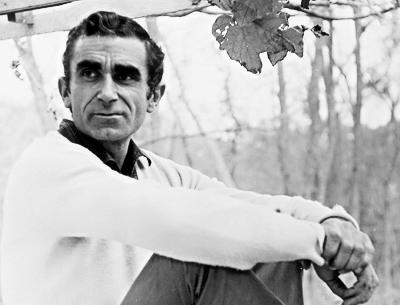Opinion: Abstract and Overlooked

There is a lot of black and white in the paintings of Nicolas Carone, particularly in the works he painted in New York City. But in his East Hampton paintings from the 1950s, on view at the Pollock-Krasner House and Study Center in Springs, he worked mainly in color.
He used moody color mixed in with some areas of black and white, but not in the primary way found in his other work. In these paintings, he worked in a limited palette, with a lot of browns, oranges, and ochres mixed with patches of blue, green, and the occasional purple with gashes of red.
He described his process as automatic, letting the exterior tactile world react with his subconscious to create compositions based more on personal experience than natural phenomenon — it’s where he and Jackson Pollock found themselves kindred spirits.
Yet, it is rather easy to see the influence of the external realm of East Hampton and its environment on the painter, as filtered as it is through his particular reactions to it. In one painting from 1959, a female form is quite detectable, but he renders it perfectly in the argot of his era: masses and smears that run into one another so that the rendering is one of fleshy shapes, shadows, and a bit of line.
The paintings are rather yummy, thickly painted with each stroke defined and more reliant on form than the skeletal lines that often give his paintings structure. Line is not nonexistent here, but it does take a back seat to swathes of color colliding or balancing in pure placement next to patches of different hues. The oil-paint-and-paper support that the majority of the paintings are executed on brings out the glossiness of the medium in a way that is showy and dramatic. The few painted on canvas or on Masonite lack the life of the others.
In a recollection published in the catalog for the show, Cile Downs said it would be wrong to find direct influences of other artists in Carone’s work. She said the reality was that everyone was borrowing from one another at the time. Still, if I were to see anything in the work it would be some earlier Arshile Gorky with a bit of Willem de Kooning thrown in, particularly in the palette.
Carone, who died in 2010, was not one of the breakaway blockbuster talents who have come to define his era. He was friendly with Pollock and Lee Krasner, who found a place for him and his family to live in Springs, as well as with de Kooning, and he was a member of the Eighth Street artists club and a regular at the Cedar Bar. For many years, he also managed the Stable Gallery, one of the regular public venues for the artists of the period. Still, he was one of the many artists of that era who history brushed by.
While a Pollock drip painting can attract multimillion-dollar bids at auction, artists like Carone are not household names today. But he was respected enough to be given teaching positions at top art schools, and he won a Lee Krasner award in 2009 for lifetime achievement. In addition to founding the International School of Painting, Drawing, and Sculpture in Umbria, Italy, he had faculty positions at Cornell University, Yale University, Columbia University, the Skowhegan School of Painting and Sculpture in Maine, and Cooper Union, among others. His work is also in major museums, including the Metropolitan Museum of Art and the Whitney Museum of American Art.
There are plenty of strong paintings in the show that remain accessible for the lower-end collector. Joan Washburn, who represents the artist’s estate, was showing his work before his death and continues to do so now. Most of the works in this exhibition were lent through her gallery. Perhaps through her efforts and this show, more people will come to appreciate Carone’s unique contributions to 20th-century art.
The exhibition is on view through July 27.
